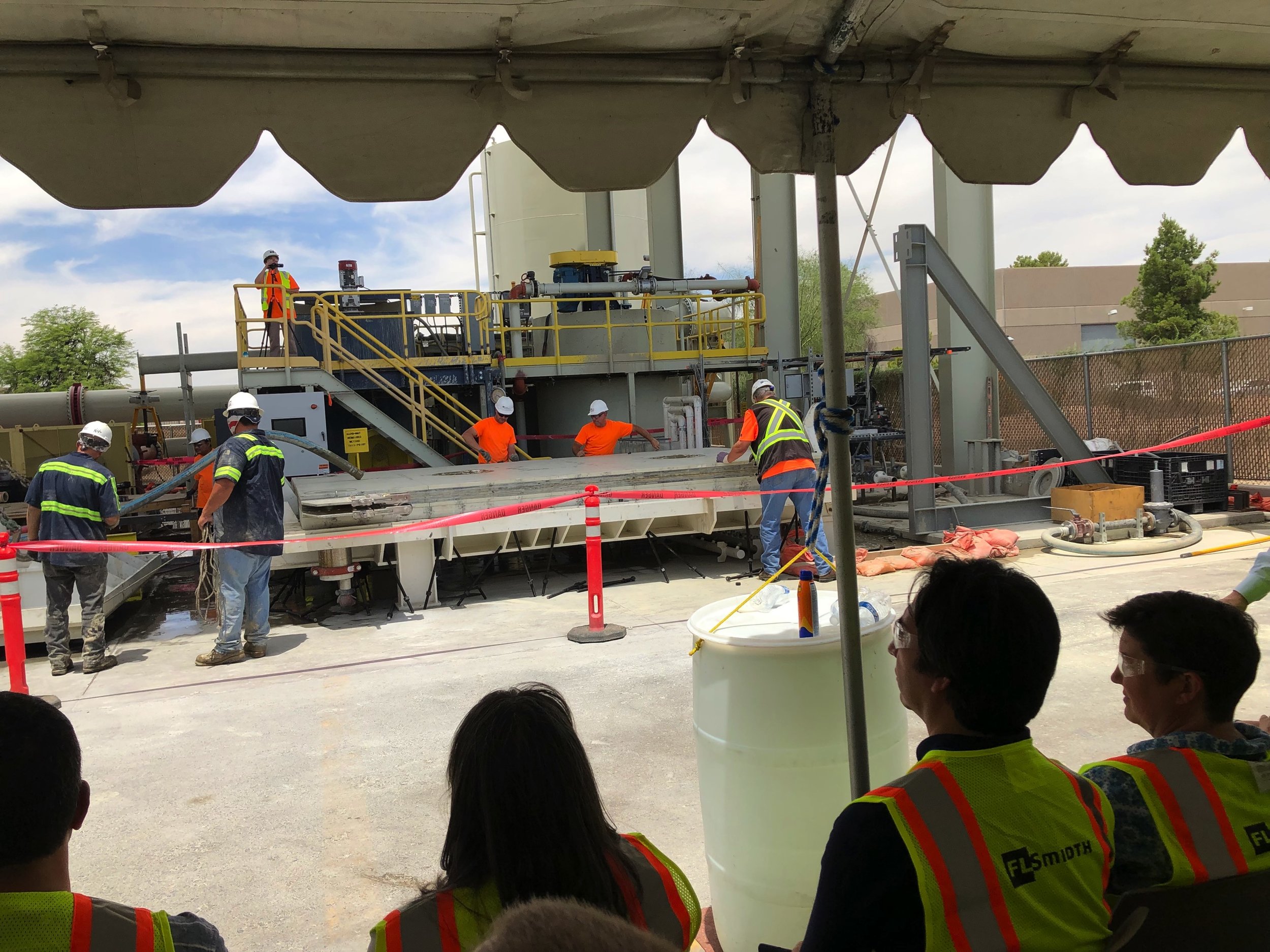FLSmidth EcoTails ® and Filtered Tailings Forum and Demonstration of World’s Largest Filtration Plate
/On June 13, 2019, I joined mining industry professionals from across North America and beyond to witness a demonstration of the world’s largest pressure filtration plate at the FLSmidth facility in Tucson, Arizona, as well as listen to presentations and a panel discussion from several industry experts on tailings management.
Over 75 leaders of some of the top companies in mining travelled to attend, a sign that tailings management is quickly becoming one of the top issues the industry faces today. Catastrophic failures of tailings dams have occurred in recent years at Mt Polley, Fundao and Brimadinho. Increasingly, miners are looking at risk management and sustainability as an investment, not just a cost, and there has been a corresponding push by mining companies to dewater tailings using available methods such as:
Tailings filtration and paste thickening
“Dry stack” tailing disposal
Paste backfill (using combination of filtered and thickened tailings) in underground mines
Co-mingling of tailings and coarser waste materials to improve geotechnical and geochemical properties.
Major filtration vendors including FLSmidth, Diemme and Outotec have been increasing scale and capacity of pressure filters in response to industry desires for reduced operating costs. The technology has been deployed on tailings for various operation flowsheets including gold leach circuits, copper and zinc flotation circuits and magnetite magnetic separation circuits. However, until now, tailings filtration has been hampered by perceptions of scale limitations (<30,000 tpd) and high operating costs ($2 - $5/t).
In recent years, Goldcorp (now Newmont-Goldcorp) partnered with FLSmidth to test and develop large scale tailings pressure filtration machines with higher reliability and faster cycle times. The demonstration unit we witnessed in Tucson has the largest pressure filtration plate ever put into service. The plate is 5 m high x 3 m wide. The available filtration area of the two sides of the plate is 25.12 m2 (total area is 30 m2 but a proportion of this is not available for filtration) and it is configured with a filtration chamber of 0.6 m3 volume. The plate used a nylon-polypropylene woven cloth as the filter media.
5 x 3 m plate with wash water sprays
Filter chamber set up with slurry feed pumping and filtrate collection
The demonstration unit was tested using a sample of tailings provided from the Newmont-Goldcorp Penasquito mine. Tailings had a size distribution of 80% passing 150 μm, typical of many industrial tailings. The chamber was filled and filtered at a pressure of 5 bar (500 kPa). This is less than full-scale unit (15 bar/1500 kPa), but filtration times can be reliably scaled up from the inverse relationship been filtration time and pressure.
For the demonstration unit, the chamber was lowered with a wireless controlled forklift, and the top of the chamber was lifted off with a crane to reveal the cake. Eventually, FLSmidth plans to build a full-scale plate and frame filter with 5 x 3 m plates vertically mounted as per typical machines (2 x 2 m).
The cake is revealed
After sampling the cake at several points across the plate, Todd Wisdom, Director Tailings Solutions at FLSmidth handed out samples for us to see and feel. He estimated the cake moisture at 16%, which could potentially be reduced in a full-scale unit using an air blow (with a corresponding increase in the filter cycle time). The cake was then successfully released from the plate by lifting one side with the crane.
Sample of filter cake, estimated at 16% moisture
After the demonstration, we heard from several speakers:
Simon Hille, Group Executive, Global Technical Engineering at Newmont-Goldcorp, who led the EcoTails ® and GeoWaste ® initiative at Goldcorp explained the journey at Penasquito to assess tailings filtration and comingling of tailings and waste rock. The drivers were to reduce water consumption and tailings failure risks and improve the geochemical characteristics of mining wastes. However larger scale filtration machines and materials handling systems were necessary to reduce operating costs and support a business case.
Dr Ward Wilson, Professor of Geotechnical and Geoenvironmental Engineering at University of Alberta spoke about the need to design waste from mining operations. Engineering suitable geotechnical and geochemical properties can help avoid catastrophic failures and issues such as acid rock drainage. He emphasized the importance of correct deposition of waste, as deposition determines the fate of the waste facility.
Rueben Neumann, Product Manager at FLSmidth spoke about the concepts for a full-scale machine with up to 160 plates, the assessment of different materials for plate construction and why fiberglass was chosen, and the innovations of the clamped media design to reduce media damage.
Kenny Don, Senior Applications Engineer at FLSmidth explained the importance of selecting filter feed pumps that have both the ability to deliver high volumes and high pressures at different times through the filter cycle, and the monitoring required to ensure reliable pump operation.
Todd Wisdom, Director Tailings Solutions at FLSmidth spoke about lessons learned from large scale tailings filtration demonstration trials at Escondida, Chile using the 2 x 4 m “Colossal” filter. He emphasized the importance of weatherizing installations, completing diligent inspections and incorporating instrumentation to detect problems such as cloth failures.
Milan Sjaus, Head of Projects and Systems Sales – North America at FLSmidth introduced us to alternative materials handling equipment and systems that can be integrated with tailings filtration. These systems, which may also include comingling tailings with waste rock, comprise of conveying, transfer and stacking systems that are configured to suit the topography of the waste disposal site at the mine. Such systems can now be designed to move > 20,000 tph of material.
Significant time and effort has already gone into the design of a full-scale filter, including finite element analysis (FEA) of the filter frame and plate design, computational fluid dynamics (CFD) of the chamber filling process, and full-scale testing of the plate and cloth washing system. A full-scale demonstration plant has been designed by Ausenco, which incorporates a full sized 5 x 3 m pressure filter with 160 chambers. Newmont-Goldcorp is actively seeking consortium partners to install the demonstration plant and prove the EcoTails ® concept at full scale. Some of the challenges that the demonstration plant will help resolve are plate handling issues with larger machines, much larger buildings, sufficient clearance to lift out plates and discharge cake and transport it away from the filter. Designs will also need to consider integration with tailings thickening, pumping and materials handling systems that may include comingling with waste rock or other materials.
I’m sure that FLSmidth’s competitors will also continue to vigorously develop larger and more cost-effective filtration machines for a variety of mining and industrial wastes including mine tailings, bauxite residue and other refinery wastes. This healthy competition should improve viability of large-scale filtration, and help mining companies evaluate and implement filtration using technology and equipment configurations most suitable for their specific needs.
The successful demonstration was an important milestone for the mining industry toward cost effective and large-scale tailings filtration and lower risk tailings facilities. I appreciated to opportunity to see it first-hand.
Acknowledgments:
Thank you to FLSmidth for the invitation to the forum and demonstration and for permission to publish photographs.









